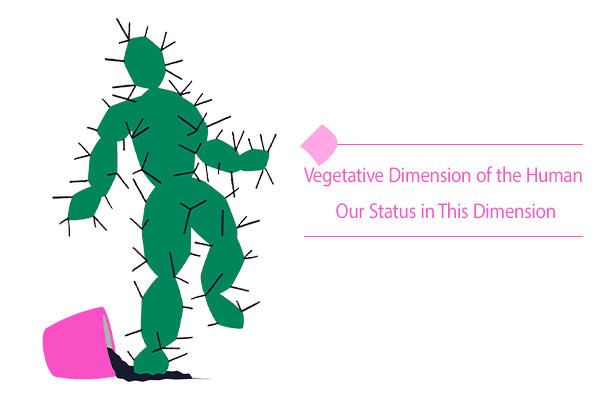Defining the Vegetative Dimension of the Human
What exists in the outside world is also inside us. In other words, the human being is a microcosm of the world. For this reason, philosophers called the universe the macrocosm and the human being the microcosm. The study of different dimensions of human existence, the philosophy of life, and the role of human beings in the universe reveal countless secrets in this regard. However, the more we move in this direction, the newer mysteries arise. Even someone like Avicenna, after a lifetime of thinking and reasoning, admits his inability to fully understand existence[1].
When we talk about different dimensions of human existence, it means that there are qualities inside us which have been overlooked. At first sight, the human being is a living being that talks, thinks, has free will and the power to make decisions, and feels emotions. Many people and researchers define human beings at this level. This definition is not wrong, but it is a very small part of reality. In fact, this knowledge is like the one that characters in the story “Elephant in the Dark”[2] had gained about the what-ness of the elephant: superficial and shallow.
We humans have several dimensions. Every thought that comes to our mind, every decision we make, every goal we choose, and in short, every part of our lifestyle is rooted in one of the dimensions of our existence. If we do not know these dimensions, we will spend our entire lives feeling lost and confused.
In the previous article, we introduced different dimensions of human existence and explained the inanimate dimension. In this article, we will explain the ‘vegetative dimension of the human,’ its origin, and its effects.
What Is the Difference between Living and Non-Living Beings?
In a general classification, the creatures we see around us fall into two groups:
- Non-living things
- Living beings
All these beings share the inanimate dimension, that is, the physical characteristics associated with their bodies. They have definite weight, volume, color, and smell. Their bodies are also made up of various elements.
But living beings, i.e., plants, animals, and humans do things that cannot be seen in inanimate objects. For example, plants have the ability to grow and feed themselves; animals, in addition to these abilities, have lust, anger, and voluntary movements. Humans, in addition to all of these, have the ability to think and reason and can distinguish between good and bad. Therefore, doing these things has nothing to do with the physical body because if it were so, inanimate objects should have such capabilities too. These differences lead us to find a specific origin that is the source of these actions. This particular origin is called the ‘soul.’
The ‘soul’ is a spiritual and immaterial essence, which is alive in itself; when it enters physical bodies, it makes them alive as well. It is like fire, which burns by nature, and any object that is placed next to it becomes hot.
So far, we have come to the conclusion that the soul is what makes living beings superior to non-living things. But living beings themselves are not at the same level in terms of existential effects and qualities. What is the reason for this difference?
Different Existential Qualities in Living Beings
In the article “What Is an Inherent Quality? What Does Achieving Perfection Mean?” we explained although humans, animals, and plants are all living beings, in terms of existential qualities, humans are superior to animals, and animals are superior to plants. This difference is due to the difference in soul and its capabilities.
On this basis, there are three types of ‘soul’ in the natural world. They are ranked from the lowest to the highest level as follows:
- Vegetative soul
- Animal soul
- Human soul
Creatures belong to one of these categories and show different abilities based on their qualities. For example, plants only have a vegetative soul, but animals have the qualities of plants as well, so an animal has a vegetative as well as an animal soul.
In the same way, the human soul, as the most perfect being, has all the qualities in the hierarchy of qualities. It is able to manifest each of those qualities through growing and acquiring abilities. For example, a newborn baby has inanimate qualities. It means he has a physical body with volume, color, and size. In addition, he shows vegetative qualities because he grows up. He reaches the animal level after showing anger and understanding various emotions. Only then he can walk the path of human growth.
The animal soul and the human soul are the source of animal and human qualities, which we will discuss in detail in the following articles. This article deals with the vegetative soul, its effect on the formation of the vegetative dimension of the human, and the effect of this dimension on our lives.
The Vegetative Dimension of the Human and Its Effect on Finding Inner Peace and Happiness
The vegetative soul is active not only in plants but also in animals and humans. It is responsible for growth, nutrition, and reproduction. This soul forms a dimension of existence which is called the ‘vegetative dimension of the human.’ In this dimension of existence, humans are considered a plant and display vegetative qualities.
We have already stated that growth, nutrition, softness, beauty, reproduction, childbearing, and physical strength are among vegetative qualities. So having them puts humans at the level of plants. In fact, having these qualities do not make us a human, but a plant.
Human dignity is not tied to any of these qualities. Even if someone displays these capabilities more than plants themselves, this does not make any difference in his status as a human being. That is because the potential to develop a quality does not raise that quality to a higher level and does not bring it out of its rank or reality. For example, an athlete with great physical ability is not a better human being, but he is a stronger plant. The same goes for having a nice body or face, the ability to reproduce, and other qualities which are related to the vegetative dimension of the human.
Human dignity and excellence over other creatures is not related to any of the inanimate, vegetative, and animal qualities. This is what most of us do not know, and that is why we are always wrong about ourselves and others. We regret not having non-human qualities and brag when we have them.
The root of all depressions, tensions, social and family disputes, suicide, unhealthy relationships, addictions, etc., is that we do not know our true self and what makes us calm. So we seek to meet the desires of the lower dimensions of existence, and when we finally satisfy them, we feel like a bankrupt person who has been deceived and lost all his assets in vain.
The vegetative dimension of the human has a significant impact on lifestyle because it creates desires and interests which, if not managed, overshadow our human dimension and disturb our balance. For more information on this, you can read the article “The Relation between the Human and Types of Existential Quality.”
Living beings are superior to non-living things because they have a soul. The vegetative dimension of the human is what stirs our interest in qualities like reproduction, physical strength, beauty, etc. Humans, due to having vegetative qualities, are plants and are not superior to plants. The superiority of humans over other creatures is related to their human dimension, i.e. the ‘true self.’
References
[1]. My knowledge has brought me to the point where I know that I know nothing.
[2]. The Masnavi, Book Three, Part 49

